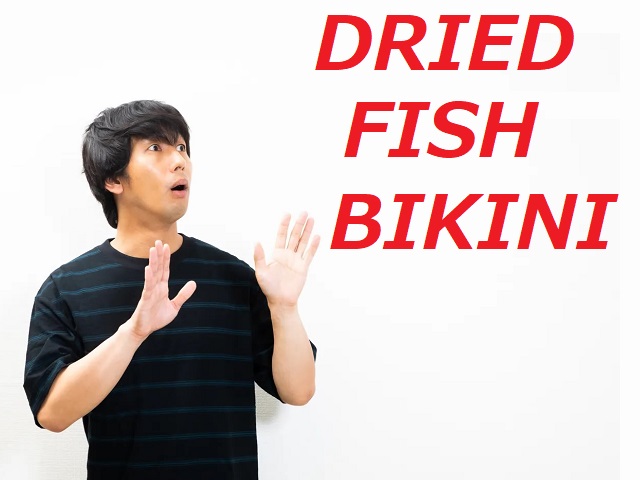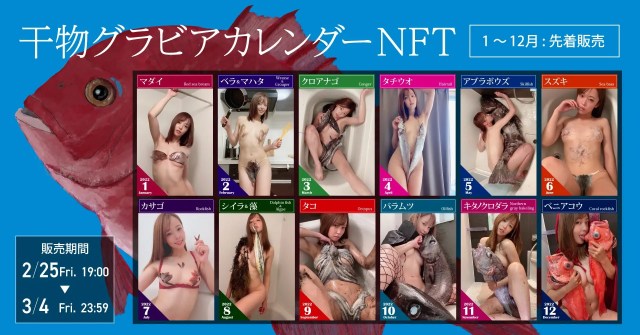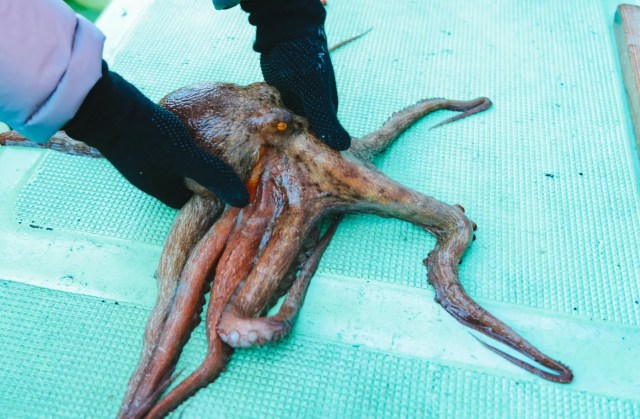Japanese swimsuit model’s dried fish bikini NFT series sells out, asking prices soar【Photos】

Octopus swimsuit NFT still relatively affordable, though.
In any crowded field, it’s a good idea to differentiate yourself. For example, Japan has a lot of gravure models, but Shihomi Yoshino’s angle is that she’s an angler too.
▼ Yoshino attending a promotional event to celebrate the release of her new DVD…
DVD発売イベントお越しくださった皆様ありがとうございました
— 吉野七宝実 (@Shihomi0305) January 23, 2022
この大変な時期に来てくれて本当にありがとうね〜
みんなが笑ってくれてるの見れてめちゃくちゃ嬉しかったよ〜pic.twitter.com/tFMWil1DEX
▼ …and catching some squid, which she said painfully bit her hands while she was landing them.
イカ釣りでした!
— 吉野七宝実 (@Shihomi0305) February 25, 2022
凶暴スルメに噛まれて結構痛かったなー
あさいさんと一緒に釣り行ったのも年末ぶりだったしめちゃくちやま楽しかった!
ふふふ、食べるのが楽しみだ! pic.twitter.com/s09hLN8zmX
Yoshino’s latest project is a foray into another sector that’s quickly filling up with competitors, NFTs. Once again, though, there’s something that sets the venture apart, as it’s a series of photographs of the 30-year-old Chiba Prefecture native posing with various kinds of fish she’s caught. As is the norm for gravure modeling, she’s dressed in a variety of revealing outfits…which also happen to be the fish she caught.
▼ Feel free to zoom in if you need a better view of the fish.

The Himono Gravure Model Calendar NFT series (himono being the Japanese word for “dried fish”) consists of 12 photos, one for each month of the year. Not only did Yoshino catch the fish, she took the photos by herself as well, using her camera’s timer. “It was hard handling the shots and composition all on my own,” she says, but she put her all into each and every fishing/photo session.
Now, obviously, the primary appeal of the images is that each lists the name of that month’s catch in both Japanese and English, making the Himono Gravure Model Calendar a valuable educational resource for those looking to improve their English or Japanese vocabulary. For those unable to read the Japanese text, or perhaps finding it hard to concentrate on it for some reason, the month-by-month list is:
● January: madai (red sea bream)
● February: bera and mahata (wrasse and grouper)
● March: kuro anago (conger)
● April: tachiuo (hairtail)
● May: abura bouzu (skilfish)
● June: suzuki (sea bass)
● July: kasago (rockfish)
● August: shiira and mo (dolphinfish [a.k.a. mahi-mahi, not to be confused with dolphin] and algae)
● September: tako (octopus)
● October: baramutsu (oilfish)
● November: kitanokurodara (northern gray hakeling)
● December: beniakou (coral rockfish)
▼ Yoshino dries her own fish, by the way, as shown in these photos of her bathroom.
こちらがグラビアアイドルのお風呂場になります pic.twitter.com/SmK8J5Kt3x
— 吉野七宝実 (@Shihomi0305) March 6, 2019
The images went on sale on the evening of February 25 through NFT online marketplace Hexa, with May (skilfish), September (octopus), October (oilfish), and December (coral rockfish) priced at 20,000 yen (US$174) each, and the rest comparative bargains at only 10,000 yen each, easily the lowest price we’ve ever seen for fish bikini NFTs.
The entire batch of 12 NFTs has since been snapped up, but they’re still being offered for sale by their new owners, with price fluctuations already starting. The biggest increase is for November (northern gray hakeling), which is now listed for sale for three million yen (US$26,085), followed by June (sea bass) at one million yen.
Meanwhile, five of the NFTs are being offered by their new owners unchanged from the original purchase price: February, April, July, September, and October. Given Japan’s artistic precedents in pairing scantily clad women with tentacled creatures, some might have expected the price for the October NFT to have skyrocketed, but Yoshino’s octopus attire actually provides significantly more coverage than several of her other outfits in the series.
▼ Could it be that buyers don’t find the two marque components of the Himono Gravure Model Calendar equally aesthetically pleasing?

明日のために大阪に向かっておる!
— 吉野七宝実 (@Shihomi0305) February 4, 2022
明日は10時から16時で大阪鶴橋の大きなお店に行きますよ!!
規制のために店舗名をきちんと伝えられなくて申し訳ないのですが、、、。
鶴橋の大きなお店です!
元気があればなんでもできるので見つけてね
(新幹線爆睡したら目充血した人) pic.twitter.com/VlKh6DnA1F
If you’re interested in acquiring any of the Himono Gravure Model Calendar NFTs (purely for study and/or investment purposes, of course), the corresponding Hexa page can be found here.
Source: PR Times, Hexa
Top image: Pakutaso (edited by SoraNews24)
Insert images: PR Times, Pakutaso
● Want to hear about SoraNews24’s latest articles as soon as they’re published? Follow us on Facebook and Twitter!
Credit:




0 comments:
Post a Comment